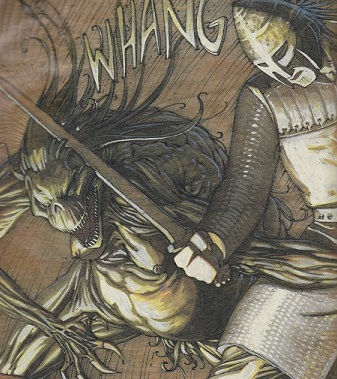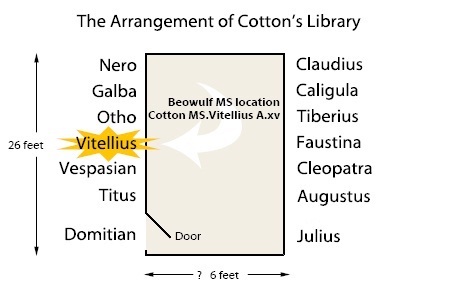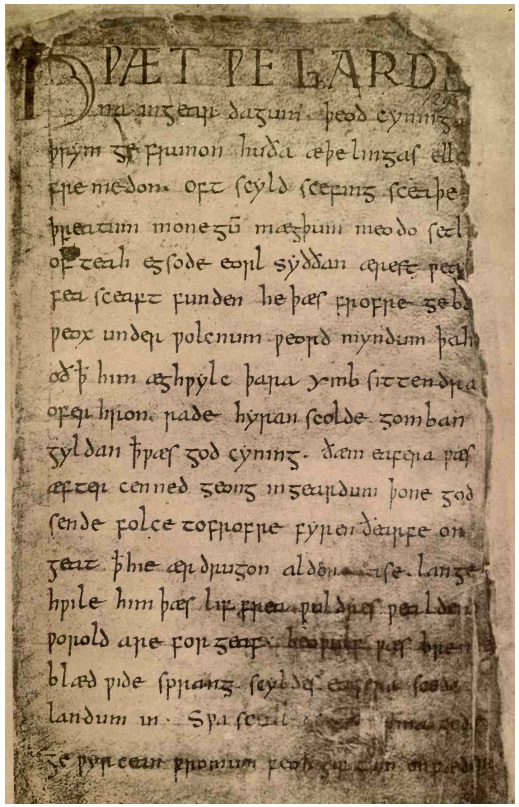The Portal to the Language of the Anglo-Saxons
The Adventurous History of the Word Wales
The Old English vocabulary had a word for 'foreigner' which is the ancestor of the Modern names Wales and Welsh.The Good Luck of the Beowulf Manuscript
Beowulf is probably the most famous Anglo-Saxon text. Its manuscript was written around 1000 A.D., but it tells of an even earlier, Germanic culture and ethos. It could not have been composed much later than the 8th century as the beginning Viking raids make it unlikely that a Danish hero would still have enjoyed much popularity among the Anglo-Saxons. The preservation of the manuscript across the ages borders a miracle. |  Beowulf fights Grendel's mother Artist's conception from a Gareth Hinds comic |
The manuscript came into the possession of Laurence Nowell, Dean of Lichfield (c. 1515 – c. 1571), an early Anglo-Saxon scholar, and author of the very first Old English dictionary, Vocabularium Saxonicum. Even today, the manuscript bears his signature on its first page and is bound in the so-called Nowell Codex.
Antiquarian Sir Robert Cotton (1571-1631) acquired the manuscript for his Cottonian library, the richest private collection of manuscripts ever amassed. The manuscripts were bound in leather and placed in fourteen bookcases, each watched over by the bust of a Roman emperor or empress. The Beowulf manuscript was the fifteenth volume on shelf A of the bookcase under the bust of emperor Vitellius. To this day, this is the official designation of the manuscript – Cotton Vitellius A. xv.

|
The Cottonian library was bequeathed to the British nation and eventually moved to Ashburnham House at Westminster, where, on October 23, 1731, a devastating fire broke out, damaging hundreds of invaluable manuscripts; completely destroying thirteen. The Beowulf manuscript, closely bound between its leather covers, survived but was scorched along its exposed edges. |
| Layout of the Cottonian Library |
Click here for an excerpt from a report on the fire from 1732
Hide report
From the "Committee Appointed to View the Cottonian Library Report", 1732:
On Saturday Morning October 23, 1731, about two o' Clock,
a great Smoak was perceived by Dr. Bentley, and the rest of the Family
at Ashburnham-House, which soon after broke out into a Flame: It began from
a wooden Mantle-Tree's taking Fire, which lay across a Stove-Chimney, that was
under the Room, where the MSS. of the Royal and Cottonian Libraries were
lodged, and was communicated to that Room by the Wainscot, and by Pieces of
Timber, that stood perpendicularly upon each end of the Mantle-Tree. They were
in hopes at first to have put a Stop to the Fire by throwing Water upon the
Pieces of Timber and Wainscot, where it first broke out, and therefore did not
begin to remove the Books so soon as they otherwise would have done. But the
Fire prevailing, notwithstanding the Means used to extinguish it, Mr. Casley
the Deputy-Librarian took Care in the first Place to remove the famous Alexandrian
MS. and the Books under the Head of Augustus in the Cottonian Library,
as being esteemed the most valuable amongst the Collection. Several entire
Presses with the Books in them were also removed; but the Fire increasing
still, and the Engines sent for not coming so soon as could be wished, and
several of the Backs of the Presses being already on Fire, they were obliged to
be broke open, and the Books, as many as could be, were thrown out of the
Windows.
|
The first page of Beowulf |

|
In 1753, the Beowulf manuscript was transferred to its new home, the British Museum, where it has been kept safe ever since. However, the priceless treasure did not always receive the caring attention it deserved. In fact, it suffered greater damage by careless handling in the following years than by the Ashburnham House fire. The outer portions of its pages and some of the text itself gradually crumbled away. G.J. Thorkelin, an Icelandic scholar, made two copies of the manuscript and published the first printed edition of Beowulf. His copies remain an important source for certain passages that have deteriorated so much that they are now illegible. In 1845, the British Museum mounted each leaf on a paper frame and rebound the manuscript, but it remains extremely fragile and can be handled only with the utmost care. Black-and-white facsimiles were produced in 1882 and 1969. Finally, the manuscript was digitalized as part of the Electronic Beowulf Project, which will ensure its conservation for perpetuity.
The survival of the Beowulf manuscript is little short of a miracle. It resisted the destruction of pagan poetry after the rise of Christianity in the Middle Ages. It survived the dissolution of English monasteries. It withstood the Cottonian Fire in 1731. And it weathered continuous deterioration and neglect over the centuries. By a stroke of good luck, this vital piece of Old English literature has been passed on to the present day, to be enjoyed by us and many future generations to come.
- Go back to the Old English Trivia Archive
- More on Old English texts, including Beowulf, in the Links section
- Watch Beowulf and the Anglo-Saxons in the OE Media Section